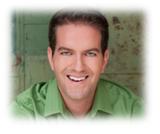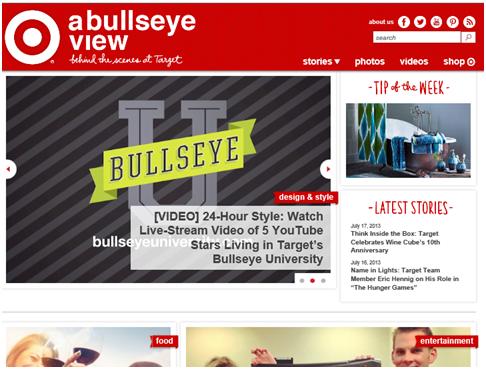On Wednesday, Jacobs Media kicked off the 38th annual Conclave with our fourth Summer School presentation. And by the sound of the feedback, it was a strong series of sessions for Conclave attendees.
I had the chance to interview both Jaye Albright, one of this year’s Rockwell Award recipients, as well as the often reclusive but very iconic Dave Hamilton, who recently stepped away from programming KQRS after more than 28 years.
And we had great “guest lecturers,” too. Beverlee Brannigan from Journal Broadcast Group provided strong insight with her “10 Things I Know For Sure” presentation. And Target’s Joe Curry took us behind the scenes and provided a deep dive into how that retailing giant works all the different social and digital channels to communicate with its various communities.
And there was a point in Joe’s presentation where he was showing attendees the way the company uses its special website, www.abullseyeview.com.
This isn’t Target’s mass market consumer website – it’s a special marketing driven site that allows the brand to take its customers behind the scenes, providing special features, from recipes to interviews with celebrities who interface with them.
As Joe showed attendees some of the more interesting features on the site, one Summer School attendee remarked that there are no banner ads on the site, and asked about how Target monetizes “A Bullseye View.”
 And for a moment, Curry looked a bit stunned, and didn’t seem to understand the question. When the question was clarified – essentially, why Target doesn’t seem to be interested in running ads on the site – Curry explained that A Bullseye View is a marketing tool, designed to engage and delight customers. It’s full of stories, features, and other Target-related content that you just don’t get from walking around the store or visiting the main website.
And for a moment, Curry looked a bit stunned, and didn’t seem to understand the question. When the question was clarified – essentially, why Target doesn’t seem to be interested in running ads on the site – Curry explained that A Bullseye View is a marketing tool, designed to engage and delight customers. It’s full of stories, features, and other Target-related content that you just don’t get from walking around the store or visiting the main website.
And that disconnect between how radio views its sites and digital assets versus how a mega-retailer like Target does hit home for me. It clearly showed the very different ways in which radio views digital – we have to monetize everything or we don’t do it – versus Target’s very different point of view that uses digital assets to enhance its brand and drive traffic to its stores, while building loyalty and customer satisfaction.
At another point, I asked Joe the thinking behind the behind-the-scenes angle that is all over this site. And he explained that there are fascinating stories that were never told about things that happen at Target – in the stores, in corporate office, and in interfacing with celebrity spokespeople – that consumers never got to see or experience. Until now.
And that led to more thinking about why radio cannot do the same thing. Funny stories from music meetings, what happened when Lady Gaga visited the station, backstage at the station’s music festival, and all the other things that occur at a radio station every week that super fans would be interested in.
Target caters to its influencers by enriching their experiences with great web content, while connecting with its fans on their favorite social sites and platform. It’s simple, direct, and truly engaging for fans.
At Summer School (and other Jacobs Media conferences), our goal is to expose radio professionals to the ways in which other industries behave and strategize, using the same tools and assets.
With Summer School and Target, I think we hit a bullseye.
- Media And Technology In 2025: Believe It Or Not! - April 18, 2025
- In Radio, You Just Never Know - April 17, 2025
- The Secret To Making A Great Podcast (And Great Radio) - April 16, 2025





YES!!! Even great broadcasters have gotten distracted by making money off gadgets, rather than use them to add brand value and attract more listeners. Radio was once the real leader & catalyst with content, promotion, personality and sizzle. Time to hit “refresh” and bring that back. I’m in! http://www.broadcastideas.com
When I joined KFOG in 1997 they were publishing a quarterly physical newsletter for database members called “FOG TRACKS” that was EXACTLY what the Target’s BullsEye Site is.
It was a small, square publication probably 4 x4 inches, printed on recycled paper in earth tone colors with a cool home-made vibe (very KFOG) and ran 8-12 pages.
It featured short little stories about what was going on behind the scenes at the station with photos – it had stories about listeners – upcoming activities etc… it was very cool.
Yes it even had “banner ads” (sponsored to offset production costs)
I didn’t realize it at the time – but it was my very first exposure to what is now very popularly called “content marketing” – probably what Target considers the BullsEye site.
I don’t know if the KFOG FOG TRACKS piece itself ran a profit – but despite having a few ads – the piece didn’t feel promotional, or like an ad or junk mail.
It really left you with a very good vibe about the station and it was a physical object that people talked about.
It eventually fell to the budget axe. The same thing could be done for less money these days.
But the real question is – who has the will to do this kind of stuff anymore?
Jeff, a great story and a reminder that it was not that long ago that many great brands were more attentive to the types of details and “nice touches” that KFOG (at its zenith) produced. That’s a far cry from today where very few stations are event thinking this way.
After listening to Joe Curry’s talk and also a similar POV from the Minnesota Twins’ Chris Iles the next day, it becomes clearer that nurturing fan interest with behind-the-scenes content is what engagement is all about.
Maybe the question has to do with vision and wherewithal and of course, staffing. It take people and a plan to pull this kind of thing off. And whether KFOG “monetized” it or not, there was a commitment that the newsletter was an integral part of their “content marketing” – or whatever they called it back then.
Thanks for the perspective, Jeff.
WalMart’s take on how to use social media platforms is one I think broadcasters should take a good look at. The Walmart POV is you shouldn’t need a big budget to have a successful media campaign. To over-simplify…you find out what’s of value to the customer then you use the usual channels like Facebook, Google+ or Twitter to invite them somewhere to have a conversation about it. They have multiple Twitter accounts for example based on the focus of the community they are talking with. Radio can do this…
https://www.cio.com/article/73577/5_Secrets_to_Corporate_Social_Media_Success
Another effective way to think about a social media strategy comes from Jay Baer and his new book YOUtility…”the difference between selling and helping is just two letters”. This turns push marketing into pull marketing. If you are sharing solutions to problems with listeners then a transaction is usually the logical conclusion. It should be a win-win but it still takes an investment in a different kind of talent to make this of value.
Great points all, Mike. Radio could benefit from the “content marketing” lessons from many big brands, and it comes down to rethinking how we use our digital assets to enhance our on-air product. What Target is doing on http://www.bullseyeview.com is very different from what they post on their main site. Thanks so much for your valuable POV.
I read all your blogs and this is one of the best. “the behind the scenes” campaign” is a really strong creative tactic for super users of any brand. It’s highly effective, creates communication between the staff and the users…really smart stuff.
Thanks so much, Dave. Target’s “content marketing” strategy is slick, and the behind-the-scenes orientation is what really makes it work. And as noted, it is so available to most stations. Appreciate you taking the time.